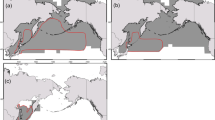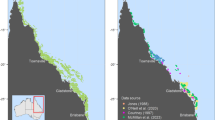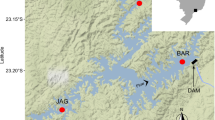Abstract
This paper presents a bioeconomic model wherefishing effort exerted has multiple impacts onthe recruitment process of a sedentaryshellfish population. Recognizing thatsedentary populations generally possessmetapopulation characteristics at therecruitment stage, we show that fishing effortexerted not only influences the recruitmentprocess indirectly by limiting the number ofadults that spawn, but also directly byaffecting the habitat in which shellfish larvaerecruit. Depending on the recruitmentcharacteristics, fishing can have negative andpositive direct and indirect effects on therecruitment process. Next, a positive directeffect that fishing can have on the growth rateof the shellfish population if space to recruitto is limited is studied. Generalcharacteristics of sustainable fishing areanalyzed for the case that recruitment occursimmediately once spawning has occurred as wellas for the case that recruitment takes placeover a longer period of time. Conditions areidentified under which shellfishing should beencouraged in order to facilitate therecruitment process of juveniles. The paperends by analyzing how fishing alters theoptimal sustainable solution when itcontributes to habitat destruction.
Similar content being viewed by others
References
Alexander, S.E. and J. Roughgarden (1996), ‘Larval Transport and Population Dynamics of Intertidal Barnacles: A Coupled Benthic/Oceanic Model’, Ecological Monographs 66, 259–275.
Brown, G. and J. Roughgarden (1997), ‘A Metapopulation Model with Private Property and a Common Pool’, Ecological Economics 22, 65–71.
Bulte, E.H. and G.C. van Kooten (1999), ‘Metapopulation Dynamics and Stochastic Bioeconomic modeling’, Ecological Economics 30, 293–299.
Clark, C.W. (1990), Mathematical Bioeconomics: The Optimal Management of Renewable Resources, 2nd edition. New York: Wiley-Interscience.
Conrad, J.M. and C.W. Clark (1987), Natural Resource Economics: Notes and Problems. Cambridge: Cambridge University Press.
Dolmer, P., P. Sand Kristensen and E. Hoffman (1999), ‘Dredging of Blue Mussels in a Danish Sound: Stock Sizes and Fishery-effects on Mussel Population Dynamic’, Fisheries Research 40, 73–80.
Eggert, H. (1998), ‘Bioeconomic Analysis and Management: The Case of Fisheries’, Environmental and Resource Economics 11, 399–411.
Gulland, J.A. (1983), Fish Stock Assessment: A Manual of Basic Methods, FAO-Wiley Series on Food and Agriculture, Vol. I. Chicester, UK: Wiley.
Honkoop, P.J.C. and J. van der Meer (1998), ‘Experimentally Induced Effects of Water Temperature and Immersion Time on Reproductive Output of Bivalves in the Wadden Sea’, Journal of Experimental Marine Biology and Ecology 220, 227–246.
Man, A., R. Law and N. Polunin (1995), ‘Role of Marine Reserves in Recruitment to Reef Fisheries: a Metapopulation Model’, Biological Conservation 71, 197–204.
Neher, P.A. (1990), Natural Resource Economics: Conservation and Exploitation. Cambridge: Cambridge University Press.
Petraitis, P.S. (1995), ‘The Role of Growth in Maintaining Spatial Dominance by Mussels (Mytilus Edulis)’, Ecology 76, 1337–1346.
Pezzey, C.V., C.M. Roberts and B.T. Urdal (2000), ‘A Simple Bioeconomic Model of a Marine Reserve’, Ecological Economics 33, 77–91.
Piersma, T., A. Koolhaas, A. Dekinga, J.J. Beukema, R. Dekker and K. Essink (2001), ‘Long-term Indirect Effects of Mechanical Cockle-dredging on Intertidal Bivalve stocks in the Wadden Sea’, Journal of Applied Ecology 38, 976–990.
Possingham, H.P. and J. Roughgarden (1990), ‘Spatial Population Dynamics of a Marine Organism with a Complex Life Cycle’, Ecology 71, 973–985.
Ricker, W.E. (1954), ‘Stock and Recruitment’, Journal of Fisheries Research Board of Canada 11, 559–623.
Sanchirico, J.N. and J.E. Wilen (1999), ‘Bioeconomics of Spatial Exploitation in a Patchy Environment’, Journal of Environmental Economics and Management 37, 129–150.
Spence, M. and D. Starrett (1975), ‘Most Rapid Approach Paths in Accumulation Problems’, International Economic Review 16, 388–403.
Sprung, M. (1983), ‘Reproduction and Fecundity of the Mussel Mytilus Edulis at Helgoland’, Helgolander. Wiss. Meeresunters 36, 243–255.
de Vooys, C.G.N. (1999), ‘Numbers of Larvae and Primary Plantigrades of the MusselMytilus Edulis in the Western Dutch Wadden Sea’, Journal of Sea Research 41, 189–201.
Author information
Authors and Affiliations
Rights and permissions
About this article
Cite this article
Imeson, R., van den Bergh, J. A Bioeconomic Analysis of a Shellfishery: The Effects of Recruitment and Habitat in a Metapopulation Model. Environmental and Resource Economics 27, 65–86 (2004). https://doi.org/10.1023/B:EARE.0000016797.30911.3f
Issue Date:
DOI: https://doi.org/10.1023/B:EARE.0000016797.30911.3f




